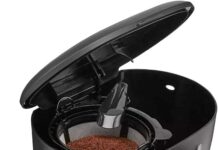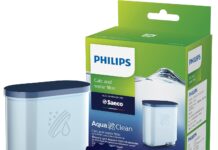Coffee lovers know the importance of a clean and well-maintained coffee maker for that perfect cup of brew. But what exactly does it mean to descale a coffee maker, and more importantly, how do you do it? Descaling a coffee maker is the process of removing mineral deposits and built-up residue that can affect the taste and efficiency of your beloved machine. In this article, we will guide you through the step-by-step process of descaling your coffee maker, ensuring that you never compromise on the quality of your morning java. So, grab a cup of coffee and let us show you how to keep your machine in top-notch condition!
What is Descaling?
Descaling is the process of removing mineral deposits and scale build-up that can accumulate inside a coffee maker over time. These deposits are primarily caused by the minerals present in water, especially in hard water areas. Descaling helps to maintain the performance and efficiency of your coffee maker, prolong its lifespan, and ensure that you continue to enjoy delicious, high-quality coffee every time you brew.
Why Should You Descale a Coffee Maker?
Remove Mineral Build-Up
One of the main reasons to descale a coffee maker is to remove mineral build-up, which can significantly affect the taste and quality of your coffee. Over time, minerals like calcium and magnesium in the water can stick to the internal components of your coffee maker, including the heating element, pipes, and valves. This residue can create blockages and affect the flow of water, leading to inconsistent brewing or even clogs. Descaling helps to dissolve and remove these mineral deposits, allowing your coffee maker to function optimally.
Improve Performance and Efficiency
When mineral deposits accumulate inside a coffee maker, it can interfere with the heating process and reduce the efficiency of the machine. This can result in longer brewing times, weak coffee, and even overheating. Descaling helps restore the heat transfer efficiency and improves the overall performance of the coffee maker. By removing the built-up scale, your coffee maker can reach and maintain the ideal brewing temperature more effectively, ensuring that you consistently brew flavorful and perfectly brewed coffee.
Extend the Lifespan of Your Coffee Maker
Regular descaling is also essential for maintaining the longevity of your coffee maker. The presence of mineral deposits can cause corrosion and damage to the internal components of the machine over time. This can lead to costly repairs or even the need for a replacement. By descaling your coffee maker regularly, you can prevent mineral deposits from causing irreversible damage and extend the lifespan of your beloved coffee-making appliance.
When to Descale
Follow Manufacturer’s Guidelines
While it’s crucial to descale your coffee maker regularly, the exact frequency may vary depending on the manufacturer’s recommendations. Some coffee maker manufacturers provide specific guidelines on when and how often to descale their machines. It’s important to consult the user manual or the manufacturer’s website to determine the appropriate descaling schedule for your particular coffee maker model.
Signs of Scale Build-Up
In the absence of manufacturer guidelines, there are some signs that indicate it’s time to descale your coffee maker. If you notice a decrease in brew quality, such as coffee that tastes bitter or stale, it may be an indication of scale build-up. Additionally, if the brewing process takes longer than usual or if you experience inconsistent water flow, it’s likely that mineral deposits have started affecting the performance of your coffee maker. Regularly inspecting the internal components and paying attention to any unusual noises or smells can also help you identify when descaling is necessary.
Types of Coffee Makers and Their Descaling Methods
Different types of coffee makers may require different descaling methods. Let’s explore the specific descaling techniques for various popular types of coffee makers:
Traditional Drip Coffee Maker
For traditional drip coffee makers, descaling typically involves running a descaling solution through the machine. The solution is often a mixture of water and a commercial descaler or a natural alternative like vinegar. Following the manufacturer’s instructions, you would fill the water reservoir with the descaling solution, run a brewing cycle, and then rinse the machine thoroughly.
Single Serve Coffee Maker
Descaling a single serve coffee maker, such as those that use coffee pods or capsules, usually follows a similar process to traditional drip coffee makers. However, it’s important to check the specific instructions provided by the manufacturer, as they may recommend using a descaling solution specifically designed for single serve machines. The descaling process may involve running multiple brewing cycles with the descaling solution and then thoroughly rinsing the machine.
Espresso Machine
Espresso machines often require more specialized descaling methods. Depending on the type of espresso machine, the descaling process may involve removing the portafilter, shower screen, and brew group to clean them separately. The descaling solution is typically run through the various components of the espresso machine, including the boiler and steam wand, followed by thorough rinsing and reassembly.
French Press
Descaling a French press is relatively straightforward compared to other types of coffee makers. The glass beaker, filter, and plunger can be disassembled and soaked in a mixture of warm water and a descaling solution. After allowing the components to soak for a recommended period, a thorough rinse ensures that any residue or mineral deposits are removed before reassembly.
Pour-Over Coffee Maker
Pour-over coffee makers, such as those using a Chemex or Hario V60, usually consist of a glass or ceramic carafe. Descaling these coffee makers involves soaking the carafe in a descaling solution or a mixture of water and vinegar. The descaling solution is then rinsed off thoroughly, ensuring that the interior of the carafe is free from any scale build-up.
Choosing the Right Descaling Solution
When descaling your coffee maker, you have several options for the descaling solution to use. Here are some common choices:
Commercial Descalers
Commercial descaling solutions are specifically formulated to remove scale build-up from coffee makers. They are often available as powders or liquids and can be purchased online or at kitchen supply stores. These descalers are designed to be effective and safe for use with various coffee maker models. It is essential to follow the manufacturer’s instructions and dosage recommendations when using commercial descaling solutions.
Natural Alternatives
If you prefer to use natural alternatives, white vinegar is a popular choice for descaling coffee makers. Vinegar is effective in breaking down mineral deposits and is readily available in most households. To use vinegar as a descaler, you would mix a solution of equal parts vinegar and water and run it through the coffee maker. However, it’s important to note that the strong odor of vinegar may linger after descaling, and thorough rinsing is necessary to eliminate any residual taste.
Homemade Descaling Solutions
Another option is to create a homemade descaling solution using ingredients such as citric acid or lemon juice. These natural acids can effectively dissolve mineral build-up without the strong odor of vinegar. However, it’s crucial to follow a reliable recipe and ensure that the acidity level is safe for your specific coffee maker model. Some homemade solutions may be too acidic and could potentially damage the internal components if used incorrectly.
Step-by-Step Guide: Descaling a Coffee Maker
To descale your coffee maker effectively, follow these step-by-step instructions:
Gather the Necessary Supplies
Before beginning the descaling process, gather all the necessary supplies. This includes the descaling solution of your choice, water, a clean cloth, and a clean brush or toothbrush for scrubbing the removable parts (if applicable).
Prepare the Coffee Maker
Start by turning off and unplugging the coffee maker. If your coffee maker has a removable water reservoir or any removable parts, take them out and set them aside for cleaning later. Empty any remaining water or coffee grounds from the machine.
Prepare the Descaling Solution
Follow the instructions provided with your chosen descaling solution to prepare the appropriate concentration or mixture. If using a commercial descaler, measure the recommended amount of powder or liquid and mix it with the appropriate amount of water. If using vinegar or a homemade solution, ensure the vinegar or acid-to-water ratio is correct.
Run the Descaling Solution through the Coffee Maker
Fill the water reservoir with the prepared descaling solution. Place the empty carafe or coffee pot securely in its place. Depending on your coffee maker model, select the brewing or descaling mode. Allow the machine to run a complete brewing cycle, ensuring that the descaling solution passes through all internal components.
Rinse and Clean the Coffee Maker
Once the descaling cycle is complete, discard the solution from the carafe or coffee pot. Rinse the carafe and any removable parts thoroughly with clean water. Fill the water reservoir with clean water and run multiple brewing cycles to ensure that any remaining traces of the descaling solution are flushed out. This step is essential to remove any residual taste or odor from the descaling process.
Final Checks and Maintenance
After completing the descaling process, wipe the exterior of the coffee maker with a clean cloth. Clean and dry any removable parts, such as the water reservoir or filter basket. Inspect the brewing area and perform any necessary maintenance, such as replacing worn-out parts or cleaning the filter assembly. Consult the manufacturer’s instructions for specific maintenance tasks recommended for your coffee maker model.
Additional Tips for Descaling
Frequency of Descaling
Determining the frequency of descaling depends on various factors. The hardness of the water in your area and the frequency of coffee maker use play a crucial role. As a general guideline, it is recommended to descale your coffee maker every 1-3 months. However, it’s essential to follow the manufacturer’s instructions or consult their website for specific descaling recommendations tailored to your coffee maker model.
Regular Cleaning and Maintenance
In addition to descaling, regular cleaning and maintenance are essential for the optimal performance of your coffee maker. Cleaning the removable parts after each use, emptying and rinsing the water reservoir daily, and wiping the exterior of the machine keep your coffee maker in top condition. Following a consistent cleaning routine prevents the accumulation of coffee oils, residue, and bacteria, ensuring that your coffee is always fresh and flavorful.
Use Filtered Water
Using filtered or purified water can help reduce the frequency of descaling. Filtering the water removes impurities and minerals that contribute to scale build-up. If you live in an area with hard water, it’s especially beneficial to use filtered water when brewing coffee. Not only does this result in better-tasting coffee, but it also helps prolong the lifespan of your coffee maker.
Avoid Harsh Chemicals
When descaling, it’s important to avoid using harsh chemicals or abrasive cleaners that can damage the internal components of your coffee maker. Stick to descaling solutions specifically designed for coffee makers and follow the manufacturer’s instructions. Avoid alternative cleaning solutions that may contain bleach, chlorine, or other aggressive chemicals.
Follow Manufacturer’s Instructions
Every coffee maker model may have specific descaling instructions provided by the manufacturer. It’s essential to read and follow these instructions carefully to ensure that you descale your coffee maker effectively and without causing any damage. Following the manufacturer’s instructions also ensures that your warranty remains valid.
Common Mistakes to Avoid
Using Vinegar Incorrectly
While vinegar is a widely used natural descaling solution, it’s important to use it correctly to avoid any potential issues. Using undiluted vinegar or a higher-than-recommended concentration can damage the internal components of your coffee maker. Additionally, thoroughly rinsing the machine after the descaling process is crucial to remove any residual vinegar taste or odor.
Incomplete Rinsing
Failing to rinse your coffee maker thoroughly after descaling can leave behind traces of the descaling solution, resulting in an unpleasant taste in your brewed coffee. Always perform multiple brewing cycles with clean water to ensure that all residues are completely flushed out.
Neglecting the Water Tank
The water tank or reservoir of your coffee maker is prone to scale build-up, especially in areas with hard water. Regularly emptying and rinsing the water tank helps prevent mineral deposits from accumulating and affecting the taste and quality of your coffee. Neglecting the water tank during the descaling process can hinder the effectiveness of the descaling solution.
Skipping Regular Maintenance
Descaling alone is not sufficient to maintain the performance and longevity of your coffee maker. Regular cleaning and maintenance tasks, such as replacing worn-out parts or cleaning the filter assembly, are equally important. Skipping these maintenance tasks can lead to inefficient brewing, decreased coffee quality, and potential damage to the machine.
Conclusion
Descaling your coffee maker is an essential maintenance task to ensure that you continue to brew delicious coffee with optimal taste and performance. By removing mineral deposits and scale build-up, descaling improves the efficiency and longevity of your coffee maker. Whether you choose a commercial descaler, a natural alternative like vinegar, or a homemade descaling solution, always follow the manufacturer’s instructions and recommended descaling frequency. Regular cleaning, using filtered water, and avoiding harsh chemicals further contribute to the proper functioning of your coffee maker. By incorporating regular descaling and maintenance into your coffee routine, you can enjoy a consistently excellent cup of coffee every time you brew.





































